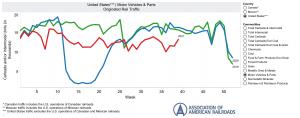A critical component of the North American transportation infrastructure, Railinc, supports commercial and government organizations with the information services they need to coordinate millions of rail-asset movements each year. It acts as the central messaging hub for the North American rail industry.
Today’s rail industry runs on data, and Railinc supplies the digital intelligence that keeps assets moving. This includes real-time insights into the location of rail assets, as well as crucial administrative documents such as trip plans, waybills, and customs declarations.
To do this, Railinc exchanges data with some 800 different industry stakeholders, at a rate of over 450,000 file transfers per day. Some customers require an especially high volume of data transfer to manage rail shipment and equipment data.
“If our MFT systems went offline unexpectedly, it would definitely have an impact on the North American rail network,” says Jeffrey Yusiewicz, Senior Messaging Administrator at Railinc. “To ensure this situation never comes about, it’s essential that we ensure maximum levels of availability for MFT.”
Iron-clad MFT for high availability
Availability 24/7 is crucial for the company’s Managed File Transfer software capabilities, which is a key enabler of its core services. It’s why Railinc uses SecureTransport — an enterprise-class Axway platform that offers leading performance, scalability, reliability, and functionality for mission-critical data transfers.
The shift came at a time when Railinc was facing growing data volumes and stricter government information processing standards, and SecureTransport provided the needed approach: a central, secure, and easy-to-manage platform that delivers end-to-end control and visibility of its MFT processes.
With Axway’s SecureTransport, Yusiewicz says the company was able to go from relying on a combination of legacy tooling and home-grown software to achieving a 99.95 percent MFT service level. SecureTransport’s high-volume raw message feed systems have been supporting 24/7 data exchange for millions of messages per day, for more than 10 years.
Adjusting responses when demand and traffic fluctuate
The Covid-19 pandemic had major impacts on global supply chains, and naturally affected Railinc’s well-established systems as well. In a recent webinar, Railinc’s Jeffrey Yusiewicz shared some rail traffic data showing massive dips on certain kinds of goods at the onset of the health crisis, such as motor vehicles and parts.

Meanwhile, Yusiewicz said demand for transportation of paint products went dramatically up as people who were sheltering at home decided to kick-start home improvement products.
There were many “up-ticks” and “down-ticks” within the system during this very demanding year, and Yusiewicz explained that it became imperative to closely monitor the whole system in addition to application aspects.
Yusiewicz recalls one morning when two different manufacturers started moving cars again on the same day — after these cars had been sitting in holding during the initial slump of the pandemic. It caused a sudden, unexpected influx of messages, but with SecureTransport Enterprise Cluster, Railinc’s teams were able to scale their systems to handle the unusual peak load.
SecureTransport allowed visibility into their data, and Railinc teams could export logs and run analyses. Meanwhile, proactive monitoring (like looking at trends) continues to have big benefits.
Learn more about how Railinc weathered the challenges of the past year and a half, adapting to unusual peaks and valleys, with the on-demand webinar here.
Moving to the Cloud
In the midst of a very demanding year, Railinc had planned to build on its success with SecureTransport by moving from an active/passive deployment hosted on-premises to a highly available configuration in an AWS private cloud.
Cloud deployment allows Railinc to concentrate more on its key application components, and Yusiewicz explains they are looking for innovative ways to support their customers with new digital solutions, especially as MFT volumes grow steadily. Migrating SecureTransport to the cloud supports this growth in the long term, optimizing operational costs as Railinc scales out its MFT environment.
Hear more about Railinc’s move from an on-premise environment to the cloud in part three of the MFT Virtual Series with Railinc, “Moving SecureTransport to the Cloud.” Yusiewicz shares live examples of customer flows and real-world traffic examples, one month into the transition.
Planning to scale for future innovation
Now, with its migration to the cloud well underway, Railinc is also exploring the possibility of augmenting the platform with operational intelligence capabilities from Axway.
“We’re very interested in adding enhanced reporting capabilities to SecureTransport, which could help us identify and close down cyber threats more quickly,” concludes Yusiewicz. “Railinc plays a critical role in keeping North America’s rail industry moving — and SecureTransport will continue to be a key enabler of our mission-critical services.”
Learn more about how MFT SecureTransport helps Railinc keep trains running amid unexpected challenges and a move to the cloud by registering to watch the on-demand webinar.


